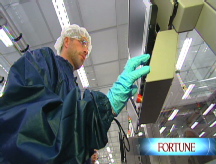SunPower's split personality
With two classes of shares on the market, investors can't seem to agree which one is more valuable.


SAN FRANCISCO (Fortune) -- Quick quiz. You have two classes of shares in a company. Class A was floated as part of the company's initial public offering. Class B represents the original ownership share of the parent company. They always existed, and therefore are non-dilutive.
Class B shares were floated after the IPO when the parent company completed its spinout. Class B shares are identical to class A, except they have eight times the voting power. Both are liquid. Which ought to be worth more?
If you answered "B" you would be correct as far as the logic goes, but wrong when it comes to the shares of solar power company SunPower Corp.
Since former parent company Cypress Semiconductor (CY) began introducing SunPower's B shares into the public markets last fall, there's been a big price gap, with A shares priced anywhere from 7% to 15% higher than B shares.
On Thursday SPWRA (SPWRA) was trading at $35 and SPWRB (SPWRB) was trading at $29. Remember: same company, same piece of ownership, same prospects.
These kinds of anomalies exist in markets, but they last about a millisecond. This one has persisted for almost six months. Here's the kicker: No one can explain it.
"Our belief is that it is a function of the market, and it is something that we have no control over," says Bob Okunski, who heads up investor relations for SunPower. "Hypothetically they should be trading at the same level."
The two classes of shares arose to sidestep tax penalties for Cypress shareholders who were granted all of the B shares. Because of that, SunPower has to wait until Oct. 2010 before it can merge or "collapse" the two share classes.
Okunski, who fields calls daily on the price gap from investors, can't wait. "We would like to collapse the shares," he says. "I think it is prudent for the investor base overall."
This being Wall Street, there are theories as to how the gap formed, and why it persists. When SPWRB shares were issued in the fall, the volume traded was much lower than SPWRB - 150,000 in a day compared with about 1.8 million.
That illiquidity might have explained the gap then - you couldn't sell them so they were worth less. But it doesn't explain it today; both share classes have plenty of trading volume on a day-to-day basis - about 2 million shares for SPWRA and 1 million for SPWRB.
The other theory among hedge fund traders is that an arbitrage play is being acted out. Investors are shorting SunPower A and going long on SunPower B. SunPower has always had a lot of short interest, and the short interest today on A today is about 20% of the shares - about four times the short interest on B. There is so much short interest on A that it is hard to borrow and requires an added carry fee.
"That makes it easier (or cheaper at least) to short B, and in theory could drive the price of B shares down," says Steve Simko, an analyst with Morningstar. Falling into a short squeeze on A shares could also keep their price up.
The big question for investors who don't want to play the short/long game is when the share classes are finally merged (or at some point in advance of that) does the B class rise or the A class fall? Or to ask the question differently: What is the fair value of the company?
Jonathan Hoopes, a managing director at Think Equity on the energy technology research team, is perhaps the only analyst who officially covers both classes of SunPower shares. Since the shares reflect the same economic opportunity of one company, he has one 12-month price target, $35. Hoopes has an "accumulate" rating on the A shares and a "buy" rating on the B shares.
"Look, I can't explain the price delta on the shares," Hoopes says, "but if you are looking to get exposure to SunPower and in the long-run believe in the prospects of the solar industry, I see no reason to buy anything other than the B shares."
Finally, something that does makes sense. ![]()
-
 The retail giant tops the Fortune 500 for the second year in a row. Who else made the list? More
The retail giant tops the Fortune 500 for the second year in a row. Who else made the list? More -
 This group of companies is all about social networking to connect with their customers. More
This group of companies is all about social networking to connect with their customers. More -
 The fight over the cholesterol medication is keeping a generic version from hitting the market. More
The fight over the cholesterol medication is keeping a generic version from hitting the market. More -
 Bin Laden may be dead, but the terrorist group he led doesn't need his money. More
Bin Laden may be dead, but the terrorist group he led doesn't need his money. More -
 U.S. real estate might be a mess, but in other parts of the world, home prices are jumping. More
U.S. real estate might be a mess, but in other parts of the world, home prices are jumping. More -
 Libya's output is a fraction of global production, but it's crucial to the nation's economy. More
Libya's output is a fraction of global production, but it's crucial to the nation's economy. More -
 Once rates start to rise, things could get ugly fast for our neighbors to the north. More
Once rates start to rise, things could get ugly fast for our neighbors to the north. More








